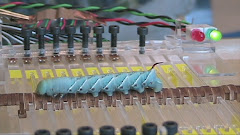Well, to be honest, the true motive for my robotic effort was purely academic. I want to learn about how animals move by making physical models of them. That's why I insist to stick with biomimcry and try to be loyal to the biological system at least in the functional level. The ways biology deals with mechanics are not always optimal and often contain constraints, but I want to have those in my robots as well so I can discover them, feel them, and characterize them.
Recently the discussion of biomimetics came up in my research group because there are a good proportion of engineers who design for functions. Of course, in the name of good engineering, we should not make biomimetic robots but bio-inspired robots. The difference is that we could learn the principles of operations in biological systems and apply these ideas and only these ideas to robotic applications. In this approach, we can leave all the biological constraints behind and attempt to optimize specific functions in our devices. For example, Dr. Shimoyma in Japan has a project that aims to recreate the swallow tail butterfly wings on his micro-ornithopter (see below).
 Taking the inspiration, they also created a tail-less micro-ornithopter with all the control electronics and sensors on-board. (very impressive works!!)
Taking the inspiration, they also created a tail-less micro-ornithopter with all the control electronics and sensors on-board. (very impressive works!!)
Of course, that's not to say I don't think about applications and moving on to bio-inspired robotics. Besides, my robots are still performing well beyond average among so many soft-bodied robotic platforms up to date. I believe that sticking to biomimetics would help us understand the nature of our biological inspirations. Surely, there is still much to learn from soft-bodied animals.

.jpg)
No comments:
Post a Comment